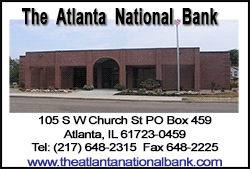|
RBS rising from ruins as
shadow of former self
 Send a link to a friend
Send a link to a friend
 [April 03, 2017]
By Andrew MacAskill and Lawrence White [April 03, 2017]
By Andrew MacAskill and Lawrence White
LONDON
(Reuters) - Nine years after the beginning of a 45-billion-pound ($56
billion) bailout by the British government, Royal Bank of Scotland
is emerging from its restructuring process a shadow of what was once the
biggest lender in the world.
RBS had a balance sheet of 2.4 trillion pounds in 2008 - almost double
Britain's annual economic output at the time - having staged a meteoric
rise from being a small Scottish lender in the early 1990s.
Since the bailout it has offloaded billions of pounds of assets a week,
as it tries to shrink down to being a simple UK-focused lender.
Later this year RBS will shut its Capital Resolution division, which has
sold off large chunks of its huge stockpile of unwanted assets. The
closure will mark a milestone in the bank's road to recovery, with its
balance sheet around 1.6 trillion pounds lighter than when its great
sell-off began.
"For the first time in a long time there is a distinction between
yesterday and tomorrow," Mark Bailie, who runs the unit told Reuters in
an interview at the lender's lender's ultra-modern glass-and-steel
offices in London's financial district.

For a graphic on rise and fall of RBS assets, click http://tmsnrt.rs/2mPV7La
RBS has undergone a huge asset sale, ranging from a fleet of aircraft in
Beijing and the largest hospital in Sydney, to a golf course 110 km from
the nearest road in Florida, and a graveyard in the U.S. Deep South.
The steep and ongoing asset-shedding, plus the deep staff and IT systems
overhaul still to come, mean the future shape of RBS and its growth
potential are still unknown propositions for investors, according to
shareholders and analysts.
"I think it is not investable at the current time. There is just too
much more work to be done," said Julian Chillingworth, chief investment
officer at Rathbone Brothers, which holds some RBS shares.
Britain's government has ruled out reducing its stake in the bank until
it resolves a multi-billion pound U.S. fine for mis-selling toxic
mortgage-backed securities and resolves its state aid requirements.
The bank's relatively small size now and the cost of its nine-year
overhaul is raising questions from politicians and industry experts over
whether taxpayers - who already face a paper loss of 29 billion pounds
on their investment - will see the kind of stellar RBS growth needed to
retrieve all their cash.
Few in the banking sector or government believe rescuing and reducing
RBS was the wrong decision, given the risks it posed to the wider
financial system. A collapse could have triggered a run on every bank in
Britain.
Still, RBS's story illustrates the perils of bailouts at a time when
state intervention is back in focus in Europe; while EU regulations have
been tightened to make state bailouts a last resort, the Rome government
is nonetheless seeking permission from European authorities to bail out
debt-laden Monte dei Paschi di Siena and two smaller Italian banks.

An RBS spokesman directed queries on whether taxpayers would retrieve
their money to comments by Chief Executive Ross McEwan last year when he
said it was possible the state would not get its full investment back.
A spokesman for the Treasury said any future sale of its stake is
dependent on market conditions, and that the government will seek value
for money for taxpayers.
90 BILLION BILL
It was three weeks after the collapse of Lehman Brothers crippled global
credit markets in 2008 that Britain's then finance minister Alistair
Darling had to make a snap decision to buy RBS.
The giant bank was hurtling towards bankruptcy so fast no one in
government had a chance to find out exactly what it owned or how to
value it.
Reuters calculations based on RBS's financial statements going back to
the crisis show how extreme the turnaround has been since then.
RBS's management has been selling or running off on average 3 billion
pounds worth of assets every week, according to the analysis which
tracked the size of the bank's balance sheet from 2008 onwards.
That's the equivalent of selling London's Shard – Western Europe's
tallest skyscraper – every five days.

[to top of second column] |

A man walks past a Royal
Bank of Scotland branch logo reflected in a puddle in London,
Britain, January 14, 2010. REUTERS/Stefan Wermuth/File Photo

In
total about 1.6 trillion pounds of assets have been stripped out of RBS's
balance sheet - equivalent to the economic output of Brazil.
Bailie, 44, a qualified accountant, was tasked with shedding much of these
unwanted assets.
"You had an unsustainable balance sheet, an unsustainable culture and an
unsustainable cost base and, therefore, I do think it will be the biggest
turnaround ever done," he said.
Much is yet to be done, according to the other senior RBS source who said the
bank had three to four years of cutbacks ahead.
Tasks range from reducing the number of payment systems from 140 to 10, and
mortgage processing systems from five to one, to cutting thousands of
back-office staff, said the source, who declined to be named as he is not
authorized to speak publicly.
Reuters calculations also put a final cost on RBS's lending losses in terms of
write-offs, plus the writedowns on assets, as well as restructuring costs, legal
bills and fines.
It tops 90 billion pounds.
That could rise further with the bank waiting to end a string of legal issues,
including the U.S. fine and a lawsuit from shareholders over a rights issue it
launched months before its bailout.
Analysts say the bank's ongoing restructuring, legal issues and growth concerns,
now it has shed assets in its lucrative investment banking business, U.S. and
insurance operations, make it difficult to recommend investing in.

Of 23 analysts covering RBS stock, only two have a "buy" recommendation,
according to Thomson Reuters data.
"Someone looked at RBS and said it's a lovely piece of fruit but it has a brown
rotten bit, let's cut that out," said Seb Walker, a managing director at data
analytics firm Tricumen. "Then you always end up cutting deeper and deeper and
you're left with a tiny core that no longer has much fruit on it."
LAST ONES STANDING
Bailie's office is on the 10th floor of RBS's London offices, where he commands
a team of about 200 employees who are still selling soured loans, as well large
stakes in companies amassed during the bank's years of rapid growth.
They work beneath fluorescent signs that say "The Clearing Warehouse", "The Wind
Down Merchants", "The Salvage Crew" and "The Last Ones Standing".
Visiting the bank's branch in Chennai, south India, Bailie said local staff took
him to a strong room to demonstrate one reason why closing the business might
not be straightforward.
He recalls a colleague opening a safe to reveal 1.2 million post-dated checks.
They often perform the role of direct debits in India, with customers sending a
series to their bank, which makes the payments to the relevant companies at the
correct times.
RBS
had to find a new lender for each customer.
"That was an interesting moment when I thought, hmm, are we going to be able to
do this?" Bailie said.
Bailie's wind-down unit also contains smaller and more esoteric assets that are
the legacy of RBS's expansion, including an abstract sculpture called 'Rock
Form' by Barbara Hepworth housed in a shopping center owned by RBS.

Bailie said this was among the hardest things the bank had to sell, because
prospective buyers of the shopping center in the west of England didn't want to
insure the artwork to keep it there. But it was precious to the local
population.
Bailie's hope is that RBS's problems are close to being resolved and that they
can now spend more time talking about the smaller, safer, profitable business
emerging from the husk of the former bank.
"This thing makes a billion pounds a quarter. You can see the light at the end
of the tunnel."
(Editing by Pravin Char)
[© 2017 Thomson Reuters. All rights
reserved.] Copyright 2017 Reuters. All rights reserved. This material may not be published,
broadcast, rewritten or redistributed. |